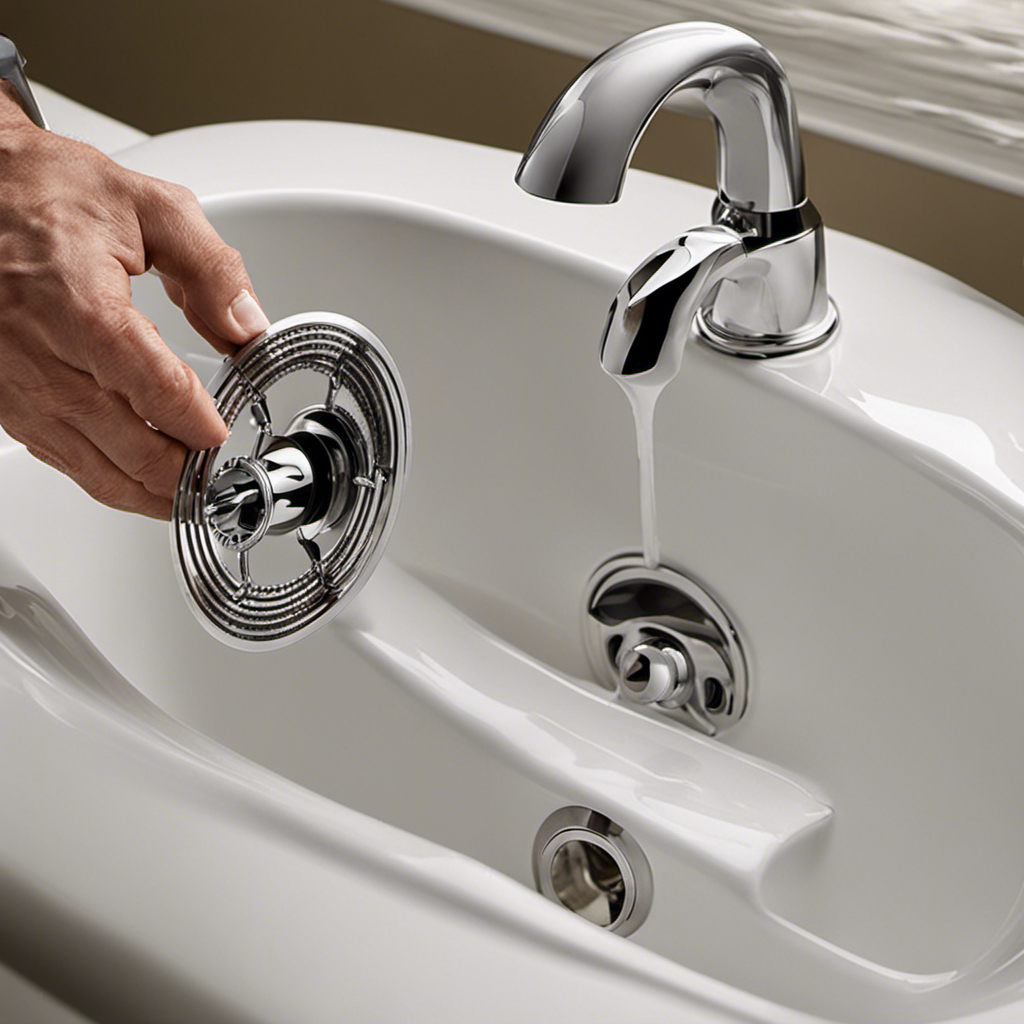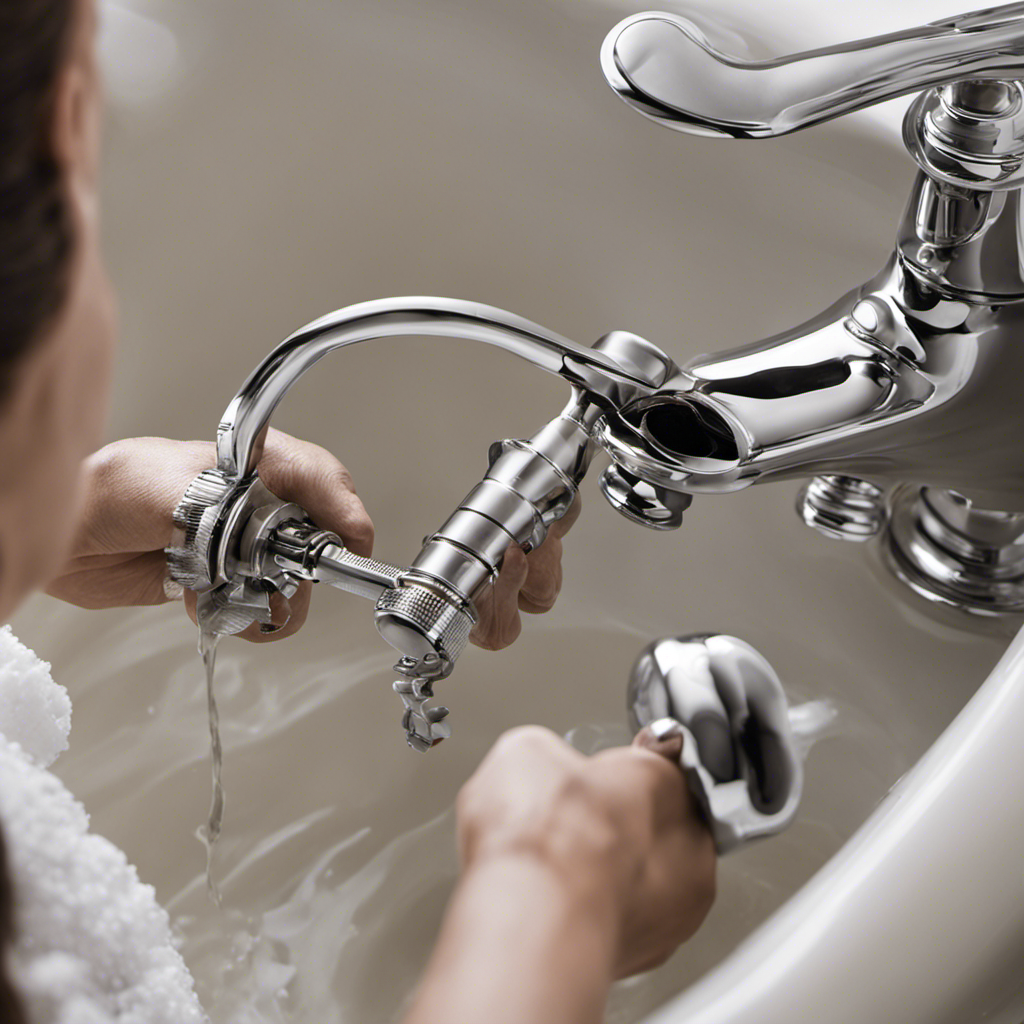Are you tired of dealing with a clogged bathtub drain? Don’t let the fear of a complicated process hold you back from taking action.
In this article, we will guide you step by step on how to take out a bathtub drain. With the right tools and a little bit of know-how, you’ll be able to remove that pesky drain cover, disconnect the pipe, and unscrew the flange in no time.
Say goodbye to clogs and hello to a smoothly flowing bathtub drain.
Key Takeaways
- Clear the area around the drain and gather cleaning supplies to effectively remove hair and prevent future clogs.
- Locate and remove the small screws that secure the drain cover before gently lifting it upwards. Use pliers if needed.
- Turn off the water supply and use a wrench to disconnect the drain pipe from the drain assembly, being cautious not to damage surrounding pipes or fixtures.
- Unscrew the drain flange using a drain key or pliers, rotating counterclockwise. Apply penetrating oil or rust dissolver if necessary.
Tools and Materials Needed
To remove a bathtub drain, you’ll need a few tools and materials. First, gather a pair of pliers, a screwdriver, and a drain key or drain removal tool. These tools will help you effectively remove the drain.
Additionally, you’ll need a new drain stopper if you plan on replacing the old one. This is a great opportunity to upgrade to a more efficient and stylish stopper. Make sure to choose a stopper that fits your drain properly.
Lastly, if you’re removing the drain to repair leaks, you may require plumber’s putty or silicone sealant to seal any gaps or cracks. These materials are essential for achieving a watertight seal and preventing further leaks.
Preparing the Bathtub Drain Area
Before starting, make sure you’ve gathered all the necessary tools for preparing the bathtub drain area.
To effectively remove hair and prevent future clogs, follow these steps:
-
Clear the area around the drain: Remove any bath mats, toys, or debris that may hinder the process.
-
Protect yourself: Wear gloves to avoid direct contact with any potential bacteria or chemicals.
-
Gather cleaning supplies: Grab a sponge, mild cleaner, and a brush to scrub the drain area thoroughly.
By preparing the bathtub drain area properly, you ensure a clean and safe environment for the removal process.
Now that the area is ready, you can move on to the next step of removing the bathtub drain cover.
Removing the Bathtub Drain Cover
Now that you’ve prepared the area, it’s time to tackle removing the cover from your bathtub drain.
To begin, locate the small screws that secure the drain cover in place. These screws are typically found on the edges of the cover or underneath it.
Using a screwdriver, carefully loosen and remove the screws. Once the screws are removed, gently lift the drain cover upwards.
If the cover doesn’t come off easily, it may be due to accumulated debris or corrosion. In such cases, try using a pair of pliers to grip the edges of the cover and give it a gentle twist while pulling upwards.
If all else fails, consider calling a professional plumber to troubleshoot the drain cover and assist in replacing it.
Disconnecting the Drain Pipe
Once you’ve removed the drain cover, it’s time to disconnect the pipe. Follow these steps to ensure a smooth process of replacing the drain stopper and sealing the drain pipe:
-
Turn off the water supply: Locate the shut-off valves and close them to prevent any water flow during the disconnection process.
-
Use a wrench to loosen the slip nut: Place a wrench on the slip nut connecting the drain pipe to the drain assembly. Rotate the wrench counterclockwise to loosen the nut.
-
Disconnect the drain pipe: Once the slip nut is loose, gently pull the drain pipe away from the drain assembly. Be cautious not to damage any surrounding pipes or fixtures.
Unscrewing and Removing the Drain Flange
To remove the drain flange from your bathtub, start by unscrewing the drain cover using a screwdriver or pliers. Once the cover is off, use a drain wrench or pliers to loosen and unscrew the drain flange from the drain pipe. Be sure to turn it counterclockwise until it comes off completely.
Removing the drain flange is an essential step in accessing the bathtub drain and performing any necessary repairs or maintenance.
Removing Drain Flange
You’ll need to unscrew the drain flange to remove it from the bathtub. Here are the steps to successfully remove the drain flange:
-
Gather the necessary tools: You’ll need a drain wrench or pliers, a screwdriver, and a cloth or towel to protect the tub’s surface.
-
Locate the setscrew: Look for a small hole or slot on the side of the drain flange. Insert the screwdriver into the setscrew and turn counterclockwise to loosen it.
-
Unscrew the drain flange: Use the drain wrench or pliers to grip the flange securely. Turn it counterclockwise to unscrew it from the drain pipe.
Unscrewing Bathtub Drain
Now, it’s time to tackle unscrewing the drain flange from the bathtub.
To begin, locate the drain flange, which is the visible part of the drain inside the bathtub. Use a drain key or pliers to grip the crossbars on the flange securely. Rotate counterclockwise to loosen and unscrew the drain flange from the drainpipe.
Be careful not to apply excessive force, as this could damage the drainpipe or flange. If the drain flange is stubborn and won’t budge, applying a penetrating oil or rust dissolver may help loosen it.
Once the drain flange is completely unscrewed, remove it from the drainpipe and set it aside.
Congratulations, you have successfully completed the first step in bathtub drain maintenance or installation!
Cleaning and Inspecting the Drain
After removing the drain cover, it’s important to thoroughly clean and inspect the drain for any debris or clogs. This will ensure that your bathtub drain functions properly and prevent future plumbing issues.
Here are some cleaning techniques and common drain problems to look out for:
-
Cleaning Techniques:
- Use a plunger to dislodge any loose debris or clogs.
- Pour a mixture of baking soda and vinegar down the drain to break down any buildup.
- Use a drain snake to remove stubborn clogs that the plunger couldn’t clear.
-
Common Drain Problems:
- Hair buildup: Hair can accumulate in the drain over time, causing clogs.
- Soap scum: Soap residue can build up and restrict water flow.
- Mineral deposits: Hard water can leave mineral deposits that block the drain.
Frequently Asked Questions
How Do I Know if I Need to Replace the Bathtub Drain Cover?
If you’re wondering if you need to replace the bathtub drain cover, look out for signs of damage or wear, such as cracks or rust. There are various replacement options available to suit your needs.
Can I Use the Same Tools and Materials to Remove Different Types of Bathtub Drains?
To safely remove different types of bathtub drains, you’ll need various tools and materials. Remember, just like using different utensils for different dishes, each drain requires specific equipment. Here are some tips to safely remove a stuck drain flange.
Is It Necessary to Turn off the Water Supply Before Removing the Bathtub Drain?
To ensure water supply safety and proper drainage maintenance, it is necessary for you to turn off the water supply before removing the bathtub drain. This will prevent any potential leaks or flooding.
How Often Should I Clean and Inspect the Bathtub Drain?
Regular maintenance of your bathtub drain is crucial to prevent clogs and ensure proper functioning. Inspect and clean it at least once a month to avoid blockages. Look for signs such as slow drainage or unpleasant odors.
What Should I Do if the Drain Flange Is Stuck and Won’t Unscrew?
If the drain flange is stuck and won’t unscrew, you can try alternative methods like using a plunger or lubricating the threads. If all else fails, it may be best to seek professional help.
Conclusion
In conclusion, taking out a bathtub drain requires patience and the right tools. By following the steps outlined in this article, you can successfully remove the drain cover, disconnect the drain pipe, and unscrew the drain flange.
Remember to clean and inspect the drain before reinstalling it. As the old saying goes, ‘Patience is a virtue.’ So take your time and you’ll have a clean and functional bathtub drain in no time.










